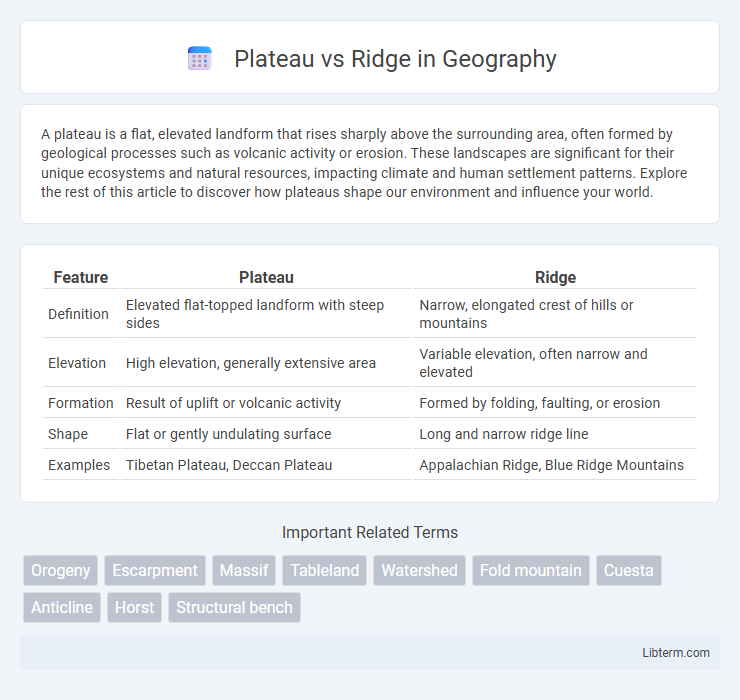A plateau is a flat, elevated landform that rises sharply above the surrounding area, often formed by geological processes such as volcanic activity or erosion. These landscapes are significant for their unique ecosystems and natural resources, impacting climate and human settlement patterns. Explore the rest of this article to discover how plateaus shape our environment and influence your world.
Table of Comparison
| Feature | Plateau | Ridge |
|---|---|---|
| Definition | Elevated flat-topped landform with steep sides | Narrow, elongated crest of hills or mountains |
| Elevation | High elevation, generally extensive area | Variable elevation, often narrow and elevated |
| Formation | Result of uplift or volcanic activity | Formed by folding, faulting, or erosion |
| Shape | Flat or gently undulating surface | Long and narrow ridge line |
| Examples | Tibetan Plateau, Deccan Plateau | Appalachian Ridge, Blue Ridge Mountains |
Definition of Plateau
A plateau is a flat, elevated landform that rises sharply above the surrounding area on at least one side, characterized by its relatively level surface and extensive horizontal expanse. In contrast, a ridge is a long, narrow elevated landform with steep sides that forms a continuous crest of hills or mountains. Plateaus often result from volcanic activity, uplift, or erosion, making them significant geological features in regions like the Colorado Plateau and Deccan Plateau.
Definition of Ridge
A ridge is a long, narrow elevated landform often characterized by a continuous crest and steep sides, formed by tectonic activity or erosion processes. Unlike a plateau, which is a broad, flat elevated area, a ridge typically has a linear shape and significant variation in elevation along its length. Ridges serve as important natural boundaries and influence local climate and water drainage patterns.
Key Geological Differences
A plateau is an elevated flat terrain that rises sharply above the surrounding area, characterized by extensive horizontal rock layers and formed primarily through volcanic activity or uplift. In contrast, a ridge is a long, narrow, elevated landform with steep sides, typically created by tectonic plate movements such as folding, faulting, or erosion of surrounding softer rock. Plateaus exhibit broad, flat surfaces while ridges feature linear crests and more pronounced relief due to their formation processes.
Formation Processes of Plateaus
Plateaus form primarily through tectonic uplift, volcanic activity, or the gradual accumulation of lava flows that create extensive flat-topped highlands. Unlike ridges, which typically arise from folded or faulted rock layers producing elongated elevations, plateaus result from widespread vertical movements of the Earth's crust or extensive volcanic eruptions covering large areas. The Colorado Plateau, for example, showcases uplifted sedimentary layers, while the Deccan Plateau emerged from massive volcanic basalt flows.
Formation Processes of Ridges
Ridges primarily form through tectonic activities such as folding, faulting, and volcanic processes that create elongated elevations on the Earth's surface. Unlike plateaus, which result from uplifted flat-lying rock layers or volcanic lava flows creating broad, level areas, ridges develop from the compression and deformation of crustal rocks, causing them to fold into narrow, linear highlands. Erosional forces then sculpt these folded structures into distinct long, narrow ridges, distinguishing their formation from the more uniform surface elevation seen in plateaus.
Physical Characteristics: Plateau vs Ridge
A plateau is an elevated flat-topped landform characterized by relatively level terrain that rises sharply above surrounding areas, often formed by tectonic uplift or volcanic activity. In contrast, a ridge is a long, narrow elevation of land, typically with steep sides and a crest or summit, formed by processes such as erosion, folding, or faulting. Plateaus tend to cover extensive areas and maintain a consistent height, while ridges are more linear and narrower, marking the highest points along mountain ranges or hills.
Notable Examples Around the World
The Tibetan Plateau, often called the "Roof of the World," stands as the largest and highest plateau on Earth, while the Rocky Mountains in North America exemplify rugged ridges formed by tectonic activity. The Deccan Plateau in India showcases extensive volcanic basalt formations, contrasting sharply with the Appalachian Ridge in the eastern United States, known for its folded mountain ridges. These distinct geological features highlight the global diversity of plateaus and ridges, each shaped by unique processes and offering significant ecological and cultural importance.
Ecological and Climatic Impact
Plateaus often support unique ecosystems due to their elevation and flat terrain, promoting biodiversity with specialized flora and fauna adapted to cooler temperatures and thinner soils, while ridges create microclimates by influencing wind patterns and precipitation distribution. The elevated flat surfaces of plateaus typically experience more stable climatic conditions compared to ridges, where sharp elevation changes cause rapid temperature fluctuations and varied moisture levels. These differences affect soil formation, water runoff, and habitat diversity, making plateaus critical for sustaining endemic species and ridges important for ecological connectivity and climate resilience.
Human Activities and Land Use
Plateaus often support extensive agricultural activities and urban settlements due to their relatively flat terrain and fertile soil, facilitating infrastructure development and irrigation practices. Ridges, characterized by steep slopes and rugged terrain, limit intensive farming but are frequently used for grazing, forestry, and recreational activities such as hiking and tourism. The distinct topography of plateaus and ridges significantly influences land use patterns, shaping human settlement distribution and economic practices in these regions.
Summary: Choosing Between Plateau and Ridge
Plateaus feature broad, flat elevated areas formed by tectonic uplift or volcanic activity, ideal for agriculture and settlement due to their stable terrain. Ridges are narrow, elongated highlands created by folding or faulting, often forming mountain ranges with steep slopes suited for hiking and natural barriers. Selecting between a plateau and a ridge depends on the desired land use, accessibility, and environmental conditions, with plateaus offering expansive flatlands and ridges providing rugged, scenic landscapes.
Plateau Infographic

 libterm.com
libterm.com